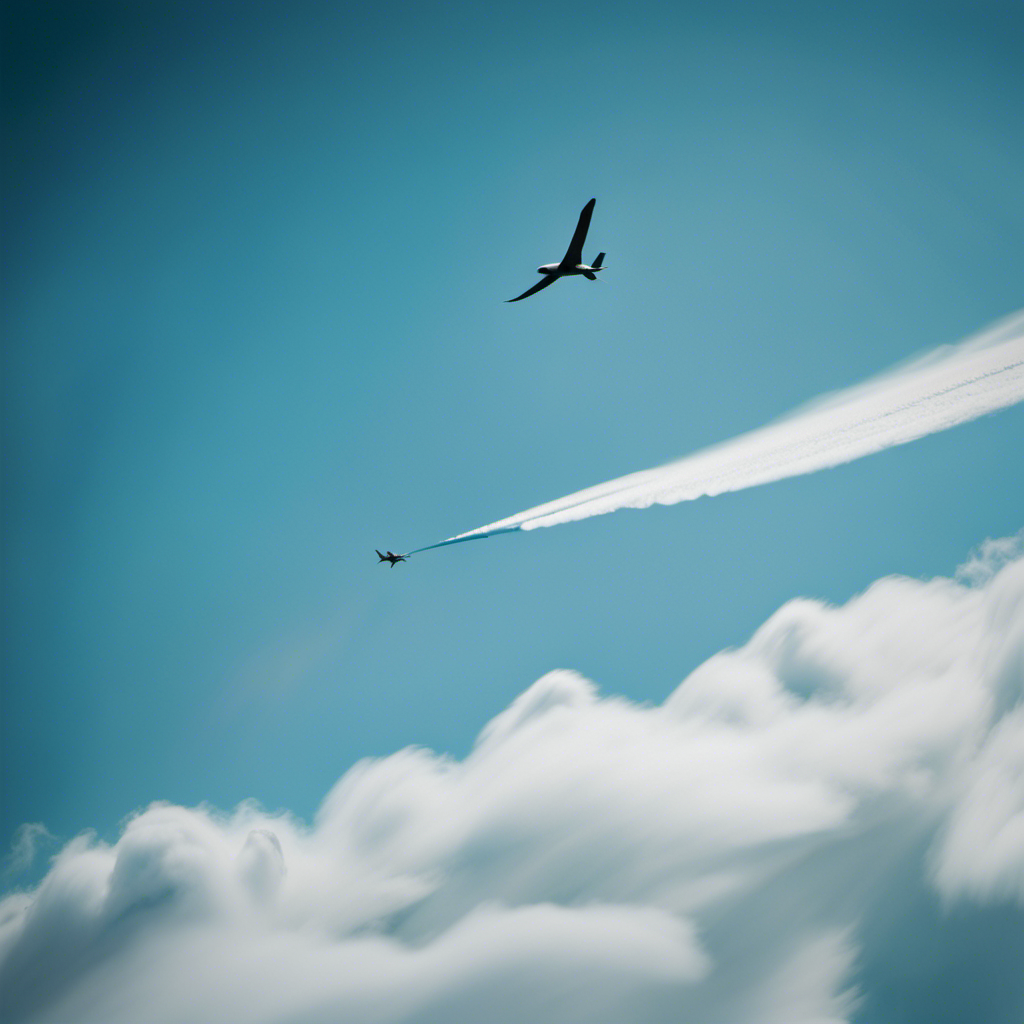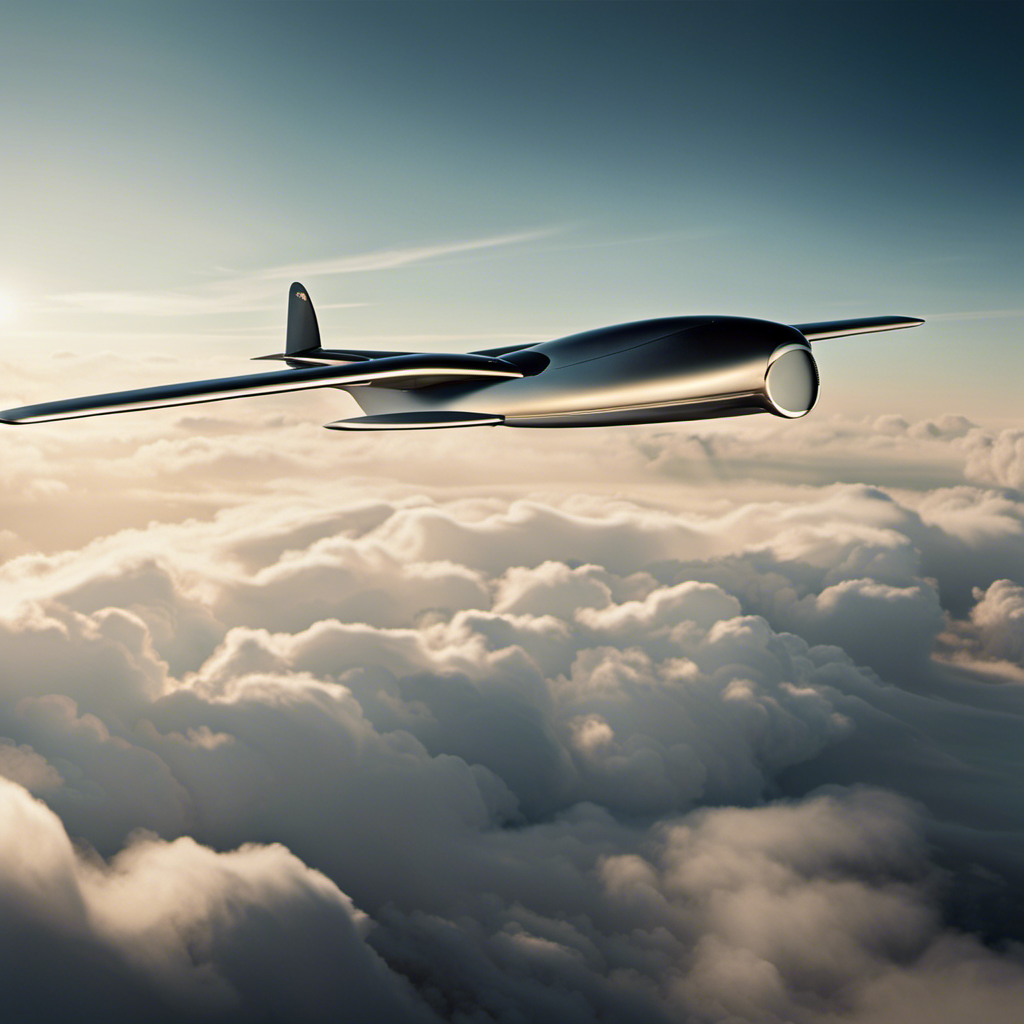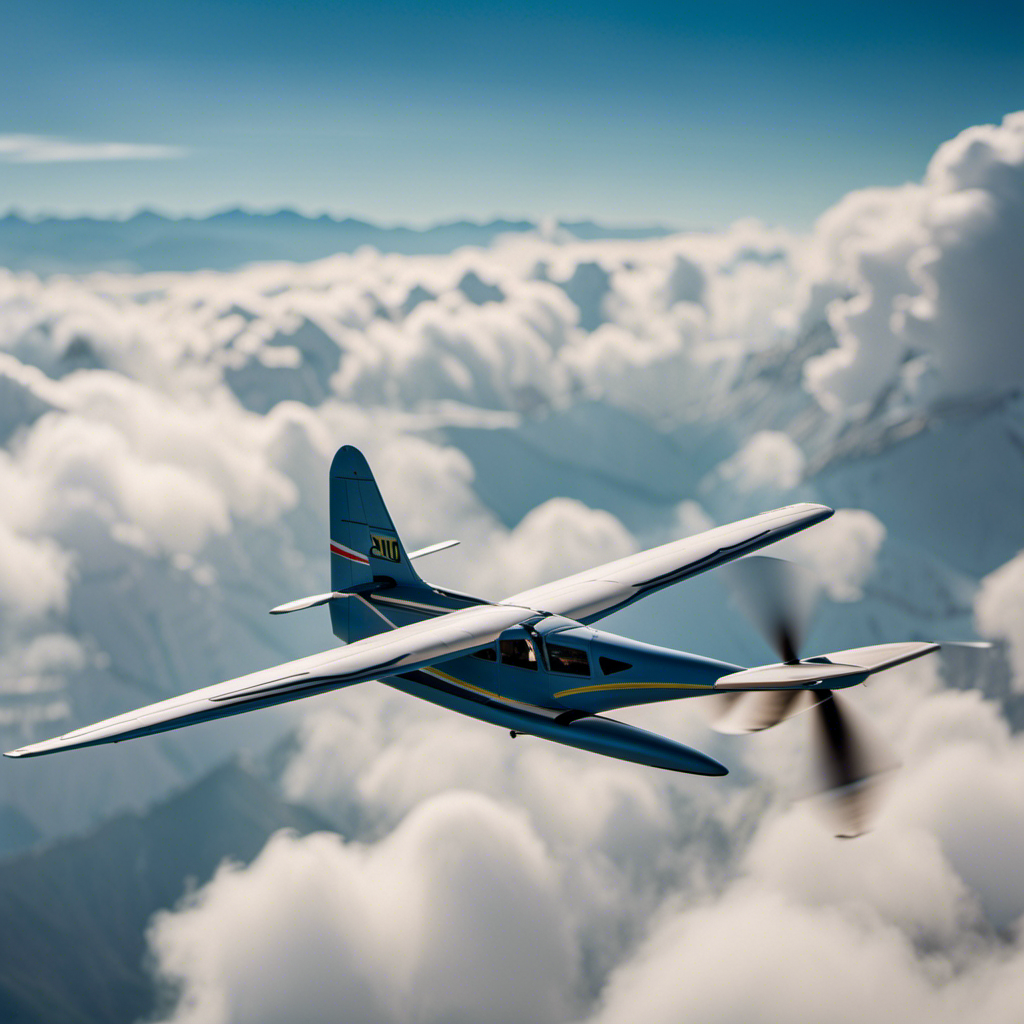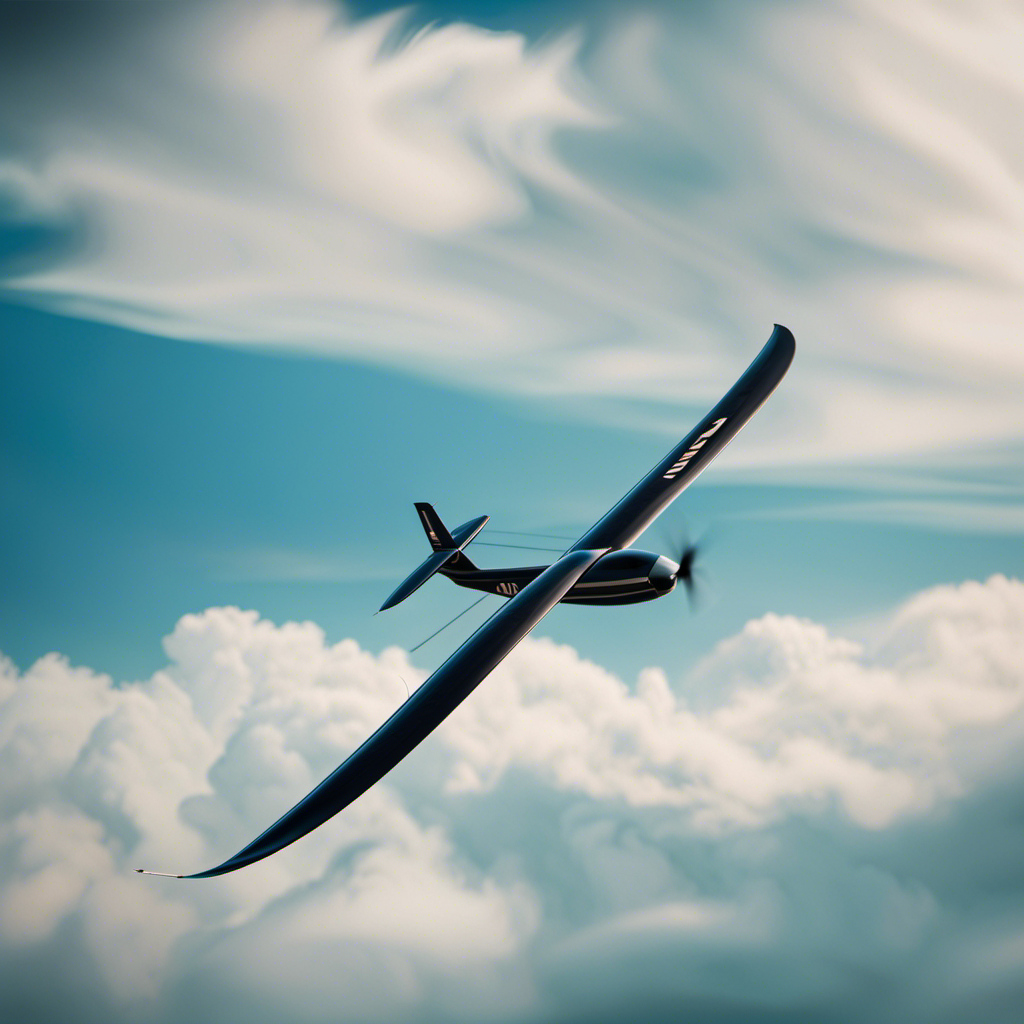While watching a glider gracefully soar through the sky, I can’t help but wonder: can it fly indefinitely?
In this article, we will delve into the intricacies of glider flight, exploring the physics behind it, the design and construction of gliders, and the techniques used by pilots to keep them aloft.
We will also examine the factors that limit glider flight and discuss the safety considerations involved.
Join me on this journey as we unravel the mysteries of gliders and explore the future developments in glider technology.
Key Takeaways
- Continuous exploration of new ways to improve glider design
- Potential for gliders to fly indefinitely with renewable energy sources
- Focus on efficient solar panels for sustained flight
- Lightweight and high-capacity batteries for continuous power
What is a Glider?
A glider is an aircraft that doesn’t have an engine, so it relies on natural forces to stay in the air. Gliders have a long and fascinating history, dating back to the late 19th century when pioneers like Otto Lilienthal and the Wright brothers began experimenting with these unpowered flying machines.
Over the years, glider technology has advanced significantly, leading to the development of sleek and efficient designs. Today, glider competitions showcase the skill and precision of pilots as they navigate through the air using only the forces of nature. These competitions test the pilots’ ability to exploit thermals, ridge lift, and other atmospheric phenomena to stay aloft and cover long distances.
Understanding the physics of glider flight is crucial for maximizing performance and achieving sustained flight without the aid of an engine.
The Physics of Glider Flight
To understand how a glider can stay airborne indefinitely, you must grasp the principles of physics that govern its flight.
The key to the glider’s ability to fly without an engine lies in the fundamental laws of physics, particularly in the field of aerodynamics. The glider utilizes the principles of lift, drag, and gravity to generate and maintain its flight.
By harnessing the upward force of lift, which is created by the shape of the glider’s wings, the glider can stay aloft. This lift is counteracted by the force of drag, which is caused by air resistance.
Glider Design and Construction
The key to designing and building a high-performing glider lies in understanding the principles of aerodynamics and carefully managing the forces of lift and drag. Glider materials and wing design are crucial factors in achieving optimal performance.
The materials used in constructing a glider need to be lightweight yet strong enough to withstand the stresses of flight. Common materials include fiberglass, carbon fiber, and balsa wood.
The wings of a glider are designed to generate lift, which is the force that counteracts gravity and keeps the glider aloft. The shape of the wings, known as the airfoil, is carefully designed to create the necessary lift while minimizing drag.
Transitioning into the next section, the design and construction of a glider greatly impact how it stays aloft and achieves efficient flight.
How Gliders Stay Aloft
Using the principles of aerodynamics and managing lift and drag forces, you can understand how gliders stay aloft.
Glider lift is generated by the shape of the wings and the angle of attack. As the glider moves through the air, the wings produce lift, which counteracts the force of gravity and keeps the glider airborne.
Drag, on the other hand, is the resistance the glider experiences due to the air. To maximize lift and minimize drag, glider pilots often search for thermal currents, which are rising columns of warm air.
Glider Piloting Techniques
By circling within thermals, glider pilots can gain altitude and extend their flight time. Glider maneuvering techniques and soaring techniques are crucial in maximizing the potential of a glider’s flight. These techniques involve skillful control of the glider’s movements to take advantage of the natural elements and air currents. Let’s take a closer look at some of these techniques:
| Technique | Description | Purpose |
|---|---|---|
| Thermaling | Circling within thermals to gain altitude | Increase altitude and extend flight time |
| Ridge soaring | Flying along the ridge of a hill or mountain | Utilize updrafts created by the wind |
| Wave riding | Riding the wave-like patterns in the atmosphere | Gain altitude through wave-induced lift |
Mastering these glider maneuvering techniques allows pilots to stay aloft longer and cover greater distances. It is fascinating to see how glider pilots use their knowledge and skills to navigate the skies with such precision and efficiency. Now, let’s explore the remarkable glider endurance records achieved by these skilled pilots.
Glider Endurance Records
To break glider endurance records, you’ll need to rely on efficient soaring techniques and favorable weather conditions. Achieving maximum flight duration in glider endurance competitions requires a combination of skill and strategy. Here are three emotional aspects that come into play:
-
Thrill of the chase: The pursuit of breaking glider endurance records creates a sense of excitement and adventure, pushing pilots to constantly push their limits and explore new possibilities.
-
Perseverance and determination: Glider pilots must possess unwavering determination and the ability to endure long hours in the sky, battling fatigue and physical discomfort.
-
Sense of accomplishment: Breaking glider endurance records brings a profound sense of accomplishment, showcasing the pilot’s skill, knowledge, and the ability to harness natural forces for extended flight durations.
But as we explore the factors that limit glider flight, we come to understand the challenges pilots face in their quest for eternal flight.
Factors That Limit Glider Flight
When it comes to glider flight, pilots often confront various factors that restrict their time in the air.
These factors can include weather conditions, such as strong winds or thunderstorms, which can make flying unsafe or impossible.
Another factor is the availability of thermal updrafts, which are essential for gliders to gain altitude and stay airborne. Without these updrafts, gliders would quickly lose altitude and have to land.
Additionally, distance and fuel limitations play a role in determining the duration of a glider flight. Gliders have no engines and rely solely on the energy they gain from the environment. This means that once the energy is depleted, the glider must land.
Understanding and managing these factors is crucial for glider pilots to ensure safe and successful flights.
Safety Considerations for Glider Flying
Make sure you’re aware of the safety considerations while flying a glider. Glider flying is subject to safety regulations, and it’s crucial to adhere to them for a safe and enjoyable flight.
Before taking off, conduct a thorough pre-flight inspection to ensure the glider is in proper working condition. Pilots must also be familiar with emergency procedures in case unexpected situations arise. These procedures may include actions to take in the event of a loss of altitude or a sudden change in weather conditions.
By being prepared and knowledgeable about safety regulations and emergency procedures, glider pilots can mitigate risks and ensure a safe flight.
Now, let’s explore the advantages of gliders.
Advantages of Gliders
When discussing the advantages of gliders, three key points come to mind: eco-friendly flying, cost-effective aviation, and a pure flying experience.
Gliders, being non-motorized aircraft, produce zero emissions, making them a sustainable and environmentally friendly option for flying.
Furthermore, glider flying is a cost-effective form of aviation, as it does not require fuel or engine maintenance.
Lastly, gliders offer a pure flying experience, devoid of the noise and distractions typically associated with powered aircraft, allowing pilots to truly connect with the art of flying.
Eco-Friendly Flying
If you want to be more eco-friendly when flying, consider using a glider that can fly for extended periods without the need for fuel. Sustainable aviation is becoming increasingly important in our efforts to reduce carbon emissions and combat climate change.
Gliders are a perfect solution to this problem, as they rely solely on the power of the air currents to stay airborne. By harnessing natural forces, gliders produce zero carbon emissions and have a minimal impact on the environment. Not only are they environmentally friendly, but gliders also offer a unique flying experience, allowing you to soar through the sky in silence and appreciate the beauty of the world below.
Transitioning into the subsequent section about cost-effective aviation, another advantage of gliders is their affordability compared to traditional aircraft.
Cost-Effective Aviation
Transitioning into the subsequent section about cost-effective aviation, another advantage of gliders is that they’re more affordable compared to traditional aircraft.
Gliders are designed with cost-saving measures in mind, making them a practical option for aviation enthusiasts on a budget. The absence of an engine reduces maintenance costs and the need for expensive fuel. Additionally, gliders have a longer lifespan compared to powered aircraft, further reducing the overall cost.
These cost-saving measures not only benefit the individual pilot but also have a positive environmental impact. By relying solely on wind currents, gliders produce zero emissions, making them an eco-friendly choice.
Transitioning into the subsequent section about the pure flying experience, gliders offer a unique opportunity to truly connect with the elements of nature.
Pure Flying Experience
To fully immerse yourself in the pure flying experience, embrace the feeling of weightlessness as you soar through the sky in a glider. Gliding offers a unique and exhilarating way to connect with the elements and experience the freedom of flight.
With no engine noise or vibrations, you can truly appreciate the serenity and tranquility of the pure flying experience. Gliders provide sustainable aviation, harnessing the power of nature to stay aloft. By utilizing thermals, updrafts, and ridge lift, gliders can remain airborne for extended periods without the need for fossil fuels.
This sustainable approach not only reduces carbon emissions but also allows for a more intimate connection with the environment. As we explore future developments in glider technology, exciting advancements in materials, aerodynamics, and energy storage will enhance the pure flying experience even further.
Future Developments in Glider Technology
As technology advances, I am continuously exploring new ways to improve glider design for longer flights.
Future advancements in glider technology hold the potential for gliders to fly indefinitely, powered by renewable energy sources.
One area of focus is the development of more efficient solar panels that can generate and store enough energy to sustain flight during the day and even overnight.
Another avenue being explored is the use of lightweight and high-capacity batteries that can store energy from renewable sources and provide continuous power to the glider’s propulsion system.
Additionally, advancements in materials and aerodynamics are being made to reduce drag and increase the glider’s overall efficiency, allowing it to glide for longer distances with minimal energy consumption.
With these future developments, the possibility of a glider flying forever becomes more achievable.
Frequently Asked Questions
Are gliders only used for recreational purposes?
Glider competitions and glider training programs demonstrate that gliders are not only used for recreational purposes. They are also utilized for competitive flying events and for training pilots in the art of soaring flight.
How do gliders navigate during flight?
Glider instruments, including variometers and compasses, are used for navigation. Glider pilots rely on their knowledge of aerodynamics and weather conditions to find thermals, which provide the lift needed to sustain flight.
Can gliders fly in bad weather conditions?
In the face of adverse weather conditions, glider pilots employ various flying techniques to ensure safety. These include closely monitoring weather forecasts, using instruments for navigation, and being prepared to land at designated landing spots if necessary.
What is the average duration of a glider flight?
The average flight time of a glider is influenced by various factors, including weather conditions, pilot skills, and aerodynamic efficiency. It is important to consider these factors when estimating the duration of a glider flight.
Are there any age or physical requirements to fly a glider?
Age restrictions and physical limitations do exist for flying a glider. Certain physical conditions may prevent someone from safely operating a glider, and there may be age restrictions in place to ensure the pilot’s capabilities.
Conclusion
In conclusion, while a glider cannot fly forever, its ability to stay aloft for extended periods of time is impressive. Through the careful application of physics, design, and piloting techniques, gliders can harness the power of the air to glide gracefully through the sky.
However, factors such as weather conditions and the limitations of human endurance ultimately determine how long a glider can stay in flight. Nevertheless, the advantages of gliders, such as their efficiency and environmental friendliness, make them a promising option for the future of aviation.
Orion, better known as “Jetstream,” is the voice that brings the stories of the skies to life. His fascination with aviation began at a young age, sparked by his father’s tales of flying and adventure. Orion’s journey into the world of gliding was serendipitous, and from the moment he took his first glider flight, he knew he had found his calling.










